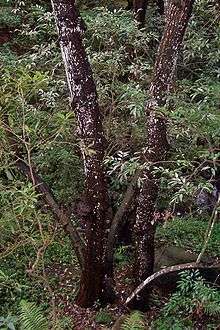Synoum
Synoum is a monotypic genus of evergreen tree in the family Meliaceae. It is endemic to Australia where it is found along the eastern sub-tropical to tropical coast, usually on the margins of rainforests, in Queensland and New South Wales.
| Synoum | |
|---|---|
 | |
| Synoum glandulosum - Chatswood West, Australia | |
| Scientific classification | |
| Kingdom: | Plantae |
| Clade: | Tracheophytes |
| Clade: | Angiosperms |
| Clade: | Eudicots |
| Clade: | Rosids |
| Order: | Sapindales |
| Family: | Meliaceae |
| Subfamily: | Melioideae |
| Genus: | Synoum A.Juss. |
| Species: | S. glandulosum |
| Binomial name | |
| Synoum glandulosum | |
The genus was originally described by French naturalist Adrien-Henri de Jussieu in 1830.[1]
The only species recognized is Synoum glandulosum, known commonly as scentless rosewood.[2] It resembles the related Toona, except that the leaves have 5-9 leaflets, whereas Toona has 8-20. Its fruit matures December to January and is a reddish three-lobed capsule that contains two or three seeds surrounded by a red aril. Germination from fresh seed is reliable and relatively fast.
The timber of Synoum is used in local construction as sawn timber for general house framing, flooring, mouldings and joinery. It is also used for furniture, shop and office fixtures, panelling, turnery, carving, as structural plywood, scaffold planks, wood wool, paper products, particleboard, and medium density fibreboard.
Gallery
 Bark on a large Synoum tree
Bark on a large Synoum tree- Synoum flower buds
 Synoum flowers
Synoum flowers
- Synoum fruit
 Base of a 15 metre tall Synoum
Base of a 15 metre tall Synoum Synoum - juvenile foliage
Synoum - juvenile foliage
References
- "Synoum". Australian Plant Name Index (APNI), IBIS database. Centre for Plant Biodiversity Research, Australian Government.
- "Synoum glandulosum (Sm.) A.Juss". Australian Plant Name Index (APNI), IBIS database. Centre for Plant Biodiversity Research, Australian Government.